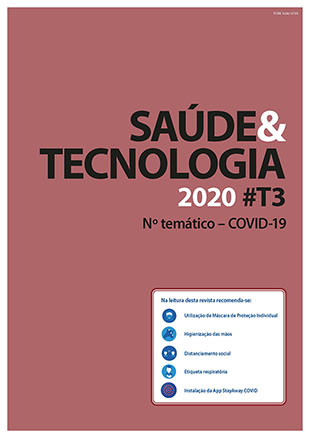COVID-19 impact in a public ophthalmology service – Report 1
DOI:
https://doi.org/10.25758/set.2266Keywords:
COVID-19, Ophthalmology service, Visual healthAbstract
The COVID-19 pandemic forced a concerted response from health services to lead to a reduction in care activity. It is a strategy to respond to this health problem centered on clinical provision and, simultaneously, on the protection of the community and health professionals. However, the direct and indirect impact on eye care is still unclear. Objective: To characterize the impact of COVID-19 in the complementary means of diagnosis and treatment (MCDT) at the ophthalmology service of a monovalent hospital. Methods: Cross-sectional study to quantify MCDT production before and after the reorganization of the services by COVID-19. Through the consultation of the informatics records of the Dr. Gama Pinto Institute of Ophthalmology (IOGP), the different MCDTs were carried out in support of the care practice in the same period of 30 days (March 11 to April 11) of 2019 were compared to 2020. Results: In the study period, there was a marked decrease with mean values of 93.5% (general consultations of Ophthalmology and Pediatric Ophthalmology) and about 76.8% (Retinal Vitreous Consultations, Ocular Diabetes, Genetics, and Visual Impairment and Rehabilitation). Discussion/Conclusion: The sharp drop in clinical production due to the COVID-19 pandemic will require a reorganization of health services in order to respond to postponed clinical situations and, simultaneously, to respond to COVID-19 ophthalmological sequelae that are unknown as retinal toxicity due to the use of chloroquine and/or hydroxychloroquine.
Downloads
References
Wu P, Duan F, Luo C, Liu Q, Qu X, Liang L, et al. Characteristics of ocular findings of patients with Coronavirus Disease 2019 (COVID-19) in Hubei Province, China. JAMA Ophthalmol. 2020;138(5):575-8.
Seah I, Agrawal R. Can the Coronavirus Disease 2019 (COVID-19) affect the eyes? A review of coronaviruses and ocular implications in humans and animals. Ocul Immunol Inflamm. 2020;28(3):391-5.
Direção-Geral da Saúde. Infeção por SARS-CoV-2 (COVID-19) - Distanciamento social e isolamento: orientação nº 010/2020, de 16/03/2020. Lisboa: DGS; 2020.
Mahase E. Covid-19: Portugal closes all medical schools after 31 cases confirmed in the country. BMJ. 2020;368:m986.
Decreto n.o 2-A/2020, de 20 de março. Diário da República. I Série(57 Suppl 1).
Jørstad ØK, Moe MC, Eriksen K, Petrovski G, Bragadóttir R. Coronavirus disease 2019 (COVID-19) outbreak at the Department of Ophthalmology, Oslo University Hospital, Norway. Acta Ophthalmol. 2020;98(3):e388-9.
Correia T. SARS-CoV-2 pandemics: the lack of critical reflection addressing short- and long-term challenges. Int J Health Plann Manage. 2020;35(3):669-72.
Romano MR, Montericcio A, Montalbano C, Raimondi R, Allegrini D, Ricciardelli G, et al. Facing COVID-19 in ophthalmology department. Curr Eye Res. 2020;45(6):653-8.
Green A. Li Wenliang. Lancet. 2020;395(10225):682.
Liu W, Zhang Q, Chen J, Xiang R, Song H, Shu S, et al. Detection of Covid-19 in children in early January 2020 in Wuhan, China. N Engl J Med. 2020;382(14):1370-1.
Wan KH, Huang SS, Young AL, Lam DS. Precautionary measures needed for ophthalmologists during pandemic of the coronavirus disease 2019 (COVID-19). Acta Ophthalmol. 2020;98(3):221-2.
Liu Z, Sun CB. Conjunctiva is not a preferred gateway of entry for SARS-CoV-2 to infect respiratory tract. J Med Virol. 2020 Apr 10. [Online ahead of print]
Loon SC, Teoh SC, Oon LL, Se-Thoe SY, Ling AE, Leo YS, et al. The severe acute respiratory syndrome coronavirus in tears. Br J Ophthalmol. 2004;88(7):861-3.
Pezzullo L, Streatfeild J, Simkiss P, Shickle D. The economic impact of sight loss and blindness in the UK adult population. BMC Health Serv Res. 2018;18(1):63.
Arentz M, Yim E, Klaff L, Lokhandwala S, Riedo FX, Chong M, et al. Characteristics and outcomes of 21 critically ill patients with COVID-19 in Washington State. JAMA. 2020;323(16):1612-4.
Grasselli G, Zangrillo A, Zanella A, Antonelli M, Cabrini L, Castelli A, et al. Baseline characteristics and outcomes of 1591 patients infected with SARS-CoV-2 admitted to ICUs of the Lombardy region, Italy. JAMA. 2020;323(16):1574-81.
Marmor MF. COVID-19 and chloroquine/hydroxychloroquine: is there ophthalmological concern? Am J Ophthalmol. 2020;213:A3-4.
Downloads
Published
Issue
Section
License
Copyright (c) 2022 Saúde e Tecnologia

This work is licensed under a Creative Commons Attribution-NonCommercial-NoDerivatives 4.0 International License.
The journal Saúde & Tecnologia offers immediate free access to its content, following the principle that making scientific knowledge available to the public free of charge provides greater worldwide democratization of knowledge.
The journal Saúde & Tecnologia does not charge authors any submission or article processing charges (APC).
All content is licensed under a Creative Commons CC-BY-NC-ND license. Authors have the right to: reproduce their work in physical or digital form for personal, professional, or teaching use, but not for commercial use (including the sale of the right to access the article); deposit on their website, that of their institution or in a repository an exact copy in electronic format of the article published by Saúde & Tecnologia, provided that reference is made to its publication in Saúde & Tecnologia and its content (including symbols identifying the journal) is not altered; publish in a book of which they are authors or editors the total or partial content of the manuscript, provided that reference is made to its publication in Saúde & Tecnologia.







